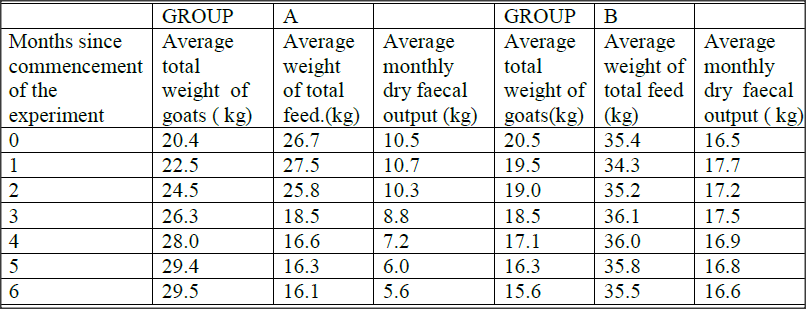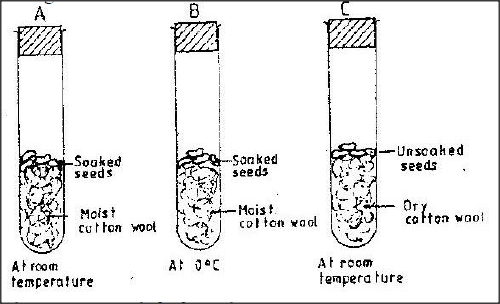|
K.C.S.E Biology Q & A - MODEL 2001PP1QN18b
State the change that take place in a flower after fertilization
answers
0 Comments
K.C.S.E Biology Q & A - MODEL 2001PP1QN18a
Describe the process of fertilization in a flowering plant
answers
pollen grains stick in the stigma surfaces; that surface of stigma producers a chemical substance; which stimulates the pollen grain to produce a pollen tube / germinate. The pollen tube/ germinate. The pollen tube grows down (into the tissues of style) from where it derives nutrients; the generative nucleaus divides to give rise to two male nuclei and the antipodal cells; when pollen tubes disintegrates and make nucleus fuses with the egg cell and forms the zygote. The other male nucleus fuss with the two polar nuclei to form a triploid nucleus. The process involves double fertilization.
K.C.S.E Biology Q & A - MODEL 2001PP1QN17b
Describe how semicircular canals perform their functions
answers
There are three semi – circular canals; arranged in planes at right angle to each other; at the end of each canal is swelling called ampulla’s which contains receptors.
The movement of the cause movement of the fluid in at least one canal, the fluid movement deflects / displaces the coperta and thus stimulating the receptors / sensory hairs, the impulse / nerve sensory impulse is transmitted / conducted to the brain; by auditory nerve, about the movement of the body / head. K.C.S.E Biology Q & A - MODEL 2001PP1QN17a
State the functions of the following parts of the mammalian ear;
(i) Tympanic membrane (ii) Eustachian tube (iii) Ear ossicles
answers
a) i) Tympanic membrane.
Receives sound waves (from the air); and vibrates / transforms sound wave into vibrations to transmit them to the ear osssicles / malleus; acc. Hammer for malleus. ii) Eustachain tube. Equalizes the air pressure in the middle ear to that in the outer ear. iii) Ear ossicles Amplify / transmits vibrations from the tymphanic membrane in the inner ear / venestra ovalis / oval window. K.C.S.E Biology Q & A - MODEL 2001PP1QN16
An experiment was carried out to investigate the nutritional value of two dry powder animals feeds X and Y over a period of six months. Twenty 5 month’s old castrated goats were use. The goats were divided into two equal groups A and B.
The animal’s in group A were fed on feed X throughout the experiment while those of group B were fed on feed Y. The feeds were supplemented with dry hay and water. The average body weight of each group of goats and the weight of the dry powder feeds were determined and recorded each month. The faeces produced by each group was dried and weighed and the average dry faecal output per month was also recorded. The results are as shown below.
(a) (i) What is the relationship between the amount of feed and the faecal output
(ii) Work out the average increase in weight for the animal’s in group A during The first four months The last two months (iii) Account for the average increase weight in goats in group A during the first four months The last two months (iv) Which of the two feeds is more nutritious? Give reason for your answer (b) State four uses of digested food in the bodies of animals (c) State four uses of water in the bodies of animals
answers
(a) (i) The more the feed the more the feacal output
The less the feed the less the faecal output (ii) The first four months
iii) Fast/ rapid/Active growth hence increase in weight
The last two months Slow growth, reached maturity iv) Feed X Give reason for your answer Group A gained (more) weight, on less food while group B lost weight on more food. b) growth, repair, protection, energy production c) a solvent, transport medium.. Hydrolyses of food, maintenance of temperature. K.C.S.E Biology Q & A - MODEL 2001PP1QN15
The diagram below represents a set up to investigate the conditions necessary for seed germination.
The set up was left for 7 days
(a) What conditions were being investigated in the experiment? (b) State three reasons for soaking seeds in set ups A and B (c) What were the expected results after seven days?
answers
(a) water, temperature moisture (Acc. Warmth)
(b) Mobilize/ hydrolyze stored food/ active enzymes/ breaking of dormancy softening the testa / seed coat ( acc. As a solvent/ transport media.) (c) Setup A – those in set up A will germinate Setup B- those in set up B will not germinate Setup C- those in set C will not germinate K.C.S.E Biology Q & A - MODEL 2001PP1QN14
Tallness in pea plants is due to a dominant gene Two tall pea plants were crossed and their F1 generation were in the ratio of 3 tall: 1 short. Using letter T to represents the gene for tallness and t for shortness give the
(a) (i) genotype of the parents (ii) Gamete of the parents (iii) Genotype ratio of the F1 generation (b) What is meant by the term testcross in genetic studies?
answers
(a) (i) Tt, Tt
(ii) Tt and Tt (iii) 1TT; 2Tt; 1tt/ 1 tall homozygous; 2 tall heterozygous 1 short homozygous 1:2:1 (b) Crossing a homozygous recessive organism with an organism which shows dominant characteristics. K.C.S.E Biology Q & A - MODEL 2001PP1QN13
The diagram below represents the nitrogen cycle
(a) State the process labeled
A D (b) Name the compound represented by B (c) Name the group of organisms labeled C (d) (i) name the group of plants which promote process A (ii) State the part of the plant where process A takes place (e) How would excess pesticides in the soil interfere with process A
answers
(a) A – Nitrogen fixation
D – absorption (b) Nitrate/ nitrates/ NO2 (c) Denitrifying bacteria/ Denitrifiers (d) (i) Leguminous plants, (acc. Legume/ acc examples e.g beans peas) (ii) Roots nodules; rej root or nodules alone; acc; root (e) – Killing / reducing of composers - Killing/reduction of nitrogen fixing bacteria/ nitrogen fixing microorganisms - Destruction of leguminous plants K.C.S.E Biology Q & A - MODEL 2001PP1QN12
The graph below shows the effect of substance concentration of the rate of enzyme reaction.
(a) (i) Account for the shape of the graph between A and B
(ii) B and C (b) How can the rate of reaction be increased after point B? (c) State two other factors that effect the rate of reaction of enzyme reaction
answers
(a) (i) More active sites of enzymes available, for a large number of molecules of substrate; hence increase in the rate of reaction ( rapid of fast increase in the rate of reaction)
(ii) B and C Enzymes/ substrate are in equilibrium / All active sites are occupied; hence rate of reaction is constant. (b) Raising concentration of enzymes (c) PH, temperature, inhibitors/ cofactors K.C.S.E Biology Q & A - MODEL 2001PP1QN11
The diagram below represents a mammalian nephron
(a) Name the
(i) Structure labeled P (ii) Portion of the nephron between point X and Y (b) Name the process that takes place at point Q (c) Name one substance present at point R but absent at point S in a healthy mammal (d) The appearance of the substance you have mentioned in (c) above is a symptom of a certain disease caused by a hormone deficiency. Name the (i) Disease (ii) Hormone (e) State the structural modifications of nephrons found in the desert mammals
answers
(a) (i) Efferent arteriole/ vessels
(ii) Loop of henle (b) Ultra – filtration ( acc. Pressure filtration) rej. Filtration (c) Glucose ( acc. Blood sugar) (d) (i) Disease – diabetes mellitus ( acc. Sugar diabetes) (ii) Hormone – insulin (e) Small Bowman’s Capsule/ Groleruli`; Rej few Bowman’s capsule Loop of Henle
K.C.S.E Biology Q & A - MODEL 2001PP1QN10
Name three sites where gaseous exchange takes place in terrestrial plants.
ANSWERS
K.C.S.E Biology Q & A - MODEL 2001PP1QN09
Name three types of chromosomal mutations
ANSWERS
K.C.S.E Biology Q & A - MODEL 2001PP1QN08b
Name the blood vessel that transports blood from:
(i) Small intestines to the liver (ii) Lungs to the heart
ANSWERS
(i) Hepatic portal vein
(ii) Pulmonary vein
K.C.S.E Biology Q & A - MODEL 2001PP1QN08a
The type of circulatory system found in members of the class insecta is
ANSWERS
K.C.S.E Biology Q & A - MODEL 2001PP1QN07
Name the organelle in which protein synthesis takes place
ANSWERS
K.C.S.E Biology Q & A - MODEL 2001PP1QN06
Adult elephants flap their ears twice as much as their calves in order to cool their bodies when it is hot. Explain.
ANSWERS
K.C.S.E Biology Q & A - MODEL 2001PP1QN05
State two functions of muscles found in the alimentary canal of mammals.
ANSWERS
K.C.S.E Biology Q & A - MODEL 2001PP1QN04
Name the parts of the flower that are responsible the production of gametes
ANSWERS
A person whose blood groups is AB requires a blood transfusion. Name the blood groups of the donors.16/6/2020
K.C.S.E Biology Q & A - MODEL 2001PP1QN03
A person whose blood groups is AB requires a blood transfusion. Name the blood groups of the donors.
ANSWERS
K.C.S.E Biology Q & A - MODEL 2001PP1QN02
Why are green plants referred to as primary producers in an ecosystem?
ANSWERS
K.C.S.E Biology Q & A - MODEL 2001PP1QN01
Other than having many features in common, state the other characteristics of a species
ANSWERS
|
Archives
December 2024
Categories
All
TOPICSFORM 1
Form 2
Form 3
Form 4
|
Can't find what you are looking for? Don't worry, Use the Search Box Below.
|
Primary Resources
College Resources
|
Secondary Resources
|
Contact Us
Manyam Franchise
P.O Box 1189 - 40200 Kisii Tel: 0728 450 424 Tel: 0738 619 279 E-mail - sales@manyamfranchise.com |














 RSS Feed
RSS Feed

